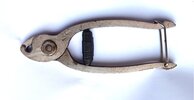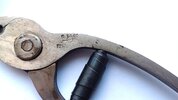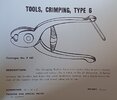British Ordnance Collectors Network
You are using an out of date browser. It may not display this or other websites correctly.
You should upgrade or use an alternative browser.
You should upgrade or use an alternative browser.
No 27 Detonators
- Thread starter MG34NZ
- Start date
F
Fuzeman
Guest
Te No27 Dets were used on aircraft bomb pistols , 1 sec delay used on bombs GP500 Lb mks 1,11, 111
Last edited by a moderator:
The No 27 was an igniferous detonator, for use in explosive demolition work and in booby traps. It may also have been used in such stores as simulators for rifle fire and as the initiator of 1 ounce primers in mortar fire and gun flash simulators. If fitted with Fuze Instantaneous it could be used with booby trap mechanisms. If fitted with Fuze Safety (safety fuze to most people) it would give the required (safe) time delay in demolitions where electric initiation wasn't used and in use of simulators. The 27 would ideally need to be used with crimpers to more securely attach the Fuze. The rectifier (Bakelite?) was to ensure that the detonator could be fitted into pre-formed channels in such things as 1 ounce primers and 1 Lb CE/TNT slabs, without having to use the detonator to make the channel wide enough! I have seen and used the type of rectifier in your photo and confirm that it appears authentic. In UK service the 27 and 33 (electric) detonators were superceded by the L1 and L2 dets in the early 1980s. I hope this is of use to you.
F
Fuzeman
Guest
Many thanks for the information,
Many thanks for this information.Te No27 Dets were used on aircraft bomb pistols , 1 sec delay used on bombs GP500 Lb mks 1,11, 111
Yes and they were widely distributed to resistance groups during W.W.II.The No 27 was an igniferous detonator, for use in explosive demolition work and in booby traps. It may also have been used in such stores as simulators for rifle fire and as the initiator of 1 ounce primers in mortar fire and gun flash simulators. If fitted with Fuze Instantaneous it could be used with booby trap mechanisms. If fitted with Fuze Safety (safety fuze to most people) it would give the required (safe) time delay in demolitions where electric initiation wasn't used and in use of simulators. The 27 would ideally need to be used with crimpers to more securely attach the Fuze. The rectifier (Bakelite?) was to ensure that the detonator could be fitted into pre-formed channels in such things as 1 ounce primers and 1 Lb CE/TNT slabs, without having to use the detonator to make the channel wide enough! I have seen and used the type of rectifier in your photo and confirm that it appears authentic. In UK service the 27 and 33 (electric) detonators were superceded by the L1 and L2 dets in the early 1980s. I hope this is of use to you.
Attachments
Thanks for the photo - I had forgotten that some rectifiers were made of wood.Yes and they were widely distributed to resistance groups during W.W.II.
Some of the later crimpers (1980s) were not as robust as those made in the 1940s, they were thinner metal and deformed after a period of use, not very good. I have one that is similar to the one on the right but mine is dated 1944. It has the same violin monogram.
Sadly, sign of the times. A few fractions of a penny saved but a tool that was not nearly as robust as before, and often quickly became unfit for purpose.
I saw a lot of that in the Infantry, including combat boots which shed their soles almost as soon as they were laced up!
Like most other time servers, I had a poly bag in the left hand top pocket of my combat jacket with safety matches, tin opener, string, various split pins and safety pins and a key for opening the metal canisters of smoke and WP grenades.
I saw a lot of that in the Infantry, including combat boots which shed their soles almost as soon as they were laced up!
Like most other time servers, I had a poly bag in the left hand top pocket of my combat jacket with safety matches, tin opener, string, various split pins and safety pins and a key for opening the metal canisters of smoke and WP grenades.
A good view of the "Strad" violin trade mark of George Ibberson & Co., "Violin" Cutlery and Plate Works, Sheffield.
I forgot to mention also that I think it was the No 27 detonator that was used with Giant Viper (anti-tank mine clearing equipment - the explosive-filled hose that was deployed using a `basket' of rocket motors).
For the record, a crimping tool Type 6 is shown, again with the violin trade mark of George Ibberson and Co.
Used with No. 8 and No.27 detonators, it is described in the SOE Devices and Supplies catalogue, but seems to have also been a general service issue tool - the Registered Design No. 830039 visible below the trade mark dates to 1938.
Used with No. 8 and No.27 detonators, it is described in the SOE Devices and Supplies catalogue, but seems to have also been a general service issue tool - the Registered Design No. 830039 visible below the trade mark dates to 1938.
Attachments
Some of the later crimpers (1980s) were not as robust as those made in the 1940s, they were thinner metal and deformed after a period of use, not very good. I have one that is similar to the one on the right but mine is dated 1944. It has the same violin monogram.
Some of them doubled as an arming tool for the Tyre Burster. The "Ear" fits into the notch on the lead screw which had to be removed in order to insert the stab-detonator (percussion) for arming the Tyre Burster.
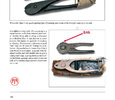 screw
screw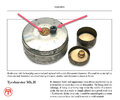




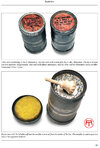
![DSCN0925[1].JPG DSCN0925[1].JPG](https://www.bocn.co.uk/data/attachments/175/175626-9d41615976b3d5706e56049241e49302.jpg)
![DSCN0925[1].JPG DSCN0925[1].JPG](https://www.bocn.co.uk/data/attachments/175/175639-c5e709aa41c3f77df9d183ecc8c05f5b.jpg)
